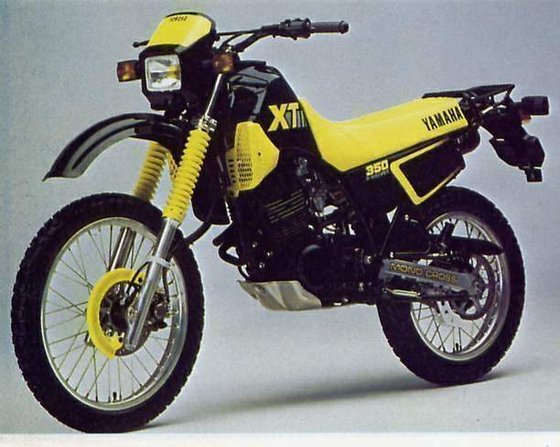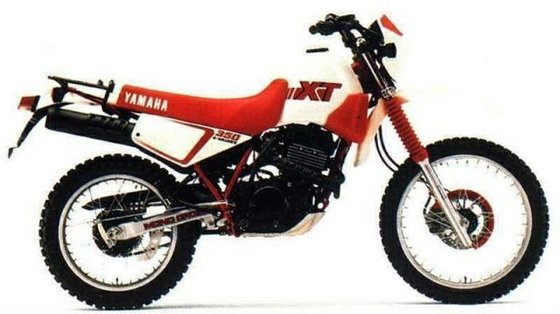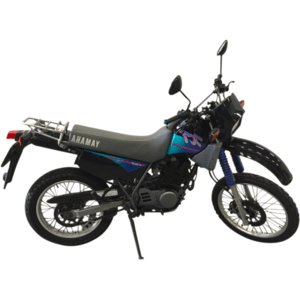Yamaha XT 350 (1985-1990) Review: The Dual-Sport Trailblazer That Still Delivers Thrills

Introduction
The Yamaha XT 350 occupies a special place in motorcycling history as a no-nonsense dual-sport machine that defined accessible off-road capability in the late 1980s. Designed to bridge the gap between street legality and dirt-ready performance, this air-cooled single-cylinder warrior became a favorite for riders seeking adventure without complexity. Even decades later, its rugged simplicity and balanced design make it a compelling choice for vintage enthusiasts and budget-minded adventurers alike. Let’s dive into what makes this motorcycle tick – and why it still puts grins on riders’ faces today.
Design & Ergonomics
The XT 350’s no-frills design screams functionality. With a slim steel frame, high-mounted fenders, and minimalist bodywork, it’s a textbook example of 1980s dirt bike aesthetics translated for street legality. The 33.6-inch (855 mm) seat height might intimidate shorter riders at standstill, but the narrow seat profile and 264.5 lb (120 kg) dry weight make it surprisingly manageable once moving.
Standout features include: - 21-inch front/18-inch spoked wheels wrapped in chunky tires (3.00-21 front, 4.00-18 rear) - High-mounted exhaust with signature angular heat shield - Rectangular headlight flanked by basic instrumentation (speedometer, warning lights) - Long-travel suspension with 10.8 inches (275 mm) of ground clearance
The riding position is classic enduro – upright bars, slightly rear-set pegs, and a neutral stance that works equally well for standing on trails or cruising backroads. While the vinyl seat feels plank-like after an hour, it’s easily upgraded with modern aftermarket options.
Engine & Performance
At its heart lies Yamaha’s 346cc air-cooled single – a DOHC, 4-valve powerhouse that was advanced for its era. With 31.5 HP (23.5 kW) @ 7,500 RPM and 21.7 lb-ft (29.5 Nm) of torque peaking at 7,000 RPM, it delivers a satisfying punch that’s more spirited than modern 300cc dual-sports.
Key characteristics: - YDIS (Yamaha Dual Intake System) carburetion provides crisp throttle response across the rev range - 6-speed transmission with tall 6th gear for relaxed highway cruising - Kickstart-only operation (test your leg muscles and technique!) - Air cooling means zero radiator maintenance but demands mindful riding in stop-and-go traffic
On pavement, the XT 350 comfortably holds 65 mph (105 km/h) with a claimed top speed of 83.9 mph (135 km/h). Off-road, the torquey engine shines – it tractor-pulls up technical climbs and easily loft the front wheel over obstacles. The exhaust note is throaty but not obnoxious, retaining that classic single-cylinder thump.
Suspension & Handling
Yamaha equipped the XT 350 with period-appropriate components that still hold up well:
Front: 36mm telescopic forks with 10.2 inches (259 mm) of travel
Rear: Mono-cross shock with adjustable preload and 9.4 inches (239 mm) wheel travel
On smooth dirt roads and moderate trails, the suspension soaks up bumps competently. Hardcore enduro riders will find limits in fast whoops or big jumps, but that’s not this bike’s intended playground. The 55.9-inch (1,420 mm) wheelbase and narrow profile make it flickable through tight singletrack, while the 21-inch front wheel rolls over rocks and ruts with confidence.
Braking is adequate rather than exciting: - Front: Single 240mm disc with 2-piston caliper - Rear: Drum brake requiring firm pedal pressure
Modern sintered pads and braided lines (available through MOTOPARTS.store) can significantly improve stopping power.
Competition
The XT 350 squared off against notable rivals in the mid-1980s dual-sport arena:
- Honda XR350R (1983-1985)
- Similar weight but with RFVC 4-valve engine
- More off-road focused (no lighting in early models)
-
Shorter 5-speed transmission Verdict: XT’s 6th gear and street-friendly features made it better for mixed use
-
Suzuki DR350S (1990-1999)
- Liquid-cooled engine with 6-speed (post-1990)
- Lower seat height (34.6”/879 mm)
-
Electric start added in 1994 Verdict: Later DRs are more refined, but XT’s simpler air-cooled design appeals to purists
-
Kawasaki KL250 (1980-1984)
- Smaller 249cc engine with 22 HP
- Lighter at 253 lb (115 kg)
- 6-speed transmission Verdict: XT’s extra 100cc provides meaningful highway capability
The XT 350 carved its niche by balancing street manners and trail competence better than most contemporaries. While later liquid-cooled bikes offered more power, the Yamaha’s mechanical simplicity remains a virtue for DIY enthusiasts.
Maintenance
Here’s where the XT 350 truly shines – its straightforward mechanics make it a dream for home wrenching:
Key Service Points
- Valve Adjustments:
Every 3,000 miles (4,800 km)
Intake: 0.08-0.12 mm (0.003-0.005”)
Exhaust: 0.13-0.17 mm (0.005-0.007”)
-
Oil Changes:
1.4L (1.48 qt) with filter using 20W-40
Pro Tip: Install a magnetic drain plug to catch metal particles -
Carb Tuning:
Y24PV carb requires periodic cleaning
Air screw baseline: 3 turns out
Idle RPM: 1,350-1,450 -
Chain Care:
128-link chain with 19T/52T sprockets
Maintain slack at 1.6-2.0” (40-50 mm)
Common Upgrades
1. LED Lighting Kit – Boost visibility with modern bulbs
2. Skid Plate – Protect the engine on rocky trails
3. Progressive Rate Springs – Improve suspension performance
4. Pivot Pegz – Wider footpegs reduce fatigue
5. Petcock Upgrade – Replace vacuum-operated fuel valve
All these parts and more are available through MOTOPARTS.store’s curated XT 350 catalog.
The Riding Experience
Throwing a leg over the XT 350 feels like stepping into a time machine – in the best possible way. The kickstart ritual (no electric assist here) demands proper technique: find TDC, give a firm downward stab, and the engine barks to life with that unmistakable single-cylinder cadence.
On pavement, the engine vibrates noticeably above 60 mph (97 km/h), but the upright riding position and wide bars make it manageable for short highway stretches. Where this bike truly comes alive is on secondary roads and forest trails. The torquey motor pulls strongly from 3,000 RPM, lofting the front wheel over drainage ditches with ease.
Standing up on the pegs reveals excellent chassis balance – even at 6’2”, there’s enough room to move around. The suspension handles moderate jumps and whoops competently, though big hits will bottom out the forks. After a day of mixed riding, you’ll appreciate the 3.1-gallon (12L) tank’s 150+ mile range.
Conclusion
The Yamaha XT 350 remains a benchmark for accessible dual-sport riding. Its combination of tractable power, rugged simplicity, and genuine off-road capability continues to win over new generations of riders. While modern bikes offer more power and gadgets, the XT’s charm lies in its mechanical purity – a machine that rewards skill and invites modification.

For owners looking to enhance their XT 350, MOTOPARTS.store offers everything from performance exhausts to vintage-style graphics kits. Whether you’re restoring a barn find or prepping for a backcountry adventure, this ’80s legend proves that great design never goes out of style.

Specifications sheet
| Engine | |
|---|---|
| Stroke: | Four-stroke |
| Ignition: | CDI |
| Starting: | Kick |
| Max power: | 23 kW | 31.0 hp |
| Max torque: | 30 Nm |
| Fuel system: | Y24PV carburetor |
| Max power @: | 7500 rpm |
| Displacement: | 346 ccm |
| Max torque @: | 7000 rpm |
| Configuration: | Single |
| Cooling system: | Air cooled |
| Compression ratio: | 9.0:1 |
| Number of cylinders: | 1 |
| Dimensions | |
|---|---|
| Wheelbase: | 1420 mm (55.9 in) |
| Dry weight: | 120 |
| Wet weight: | 140 |
| Seat height: | 855 mm (33.6 in) |
| Overall width: | 865 mm (34.0 in) |
| Overall height: | 1210 mm (47.6 in) |
| Overall length: | 2210 mm (87.0 in) |
| Ground clearance: | 275 mm (10.8 in) |
| Fuel tank capacity: | 12 L (3.17 US gal) |
| Drivetrain | |
|---|---|
| Final drive: | chain |
| Chain length: | 128 |
| Transmission: | 6-speed |
| Rear sprocket: | 52 |
| Front sprocket: | 19 |
| Maintainance | |
|---|---|
| Engine oil: | 20W40 |
| Idle speed: | 1350–1450 rpm |
| Break fluid: | DOT 4 |
| Spark plugs: | NGK DR8ES-L or NGK DR8EIX |
| Spark plug gap: | 0.7 |
| Forks oil capacity: | 0.64 |
| Engine oil capacity: | 1.4 |
| Engine oil change interval: | Every 5000 km or 2 years, whichever comes first |
| Valve clearance (intake, cold): | 0.08–0.12 mm |
| Valve clearance (exhaust, cold): | 0.13–0.17 mm |
| Recommended tire pressure (rear): | 2.3 bar (33 psi) |
| Recommended tire pressure (front): | 1.5 bar (22 psi) |



















